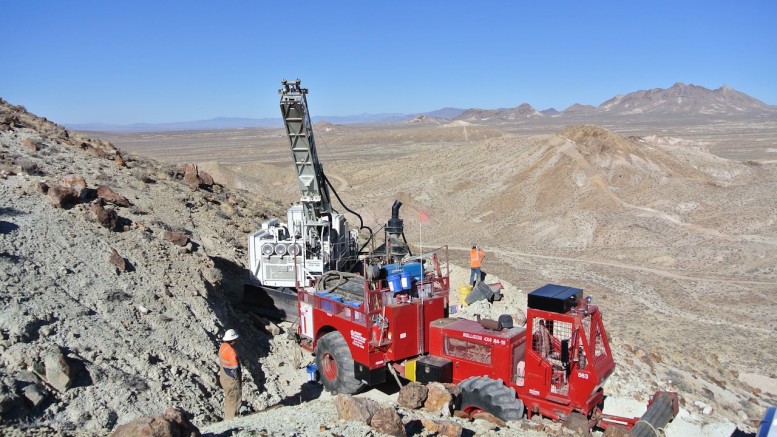West Kirkland Mining (TSXV: WKM; US-OTC: WKLDF) has added more shine to its 75%-held Hasbrouck gold-silver project in southwestern Nevada, with an updated prefeasibility study (PFS) outlining lower start-up capital for a heap-leach operation producing 74,000 equivalent oz. gold annually for nine years.
“It confirms the viability of the original study that was published last year. The key things to this project are the small amount of upfront capital and the low all-in sustaining costs to operate it. And the internal rate of return (IRR) is phenomenal, versus most other gold projects. We have a solid project,” the company’s manager of investor relations Kris Begic says.
The Hasbrouck project comprises the Three Hills and Hasbrouck oxidized gold deposits, sitting 8 km apart. West Kirkland plans to mine the deposits sequentially, starting with the fully permitted Three Hills.

The Three Hills deposit at West Kirkland Mining’s Hasbrouck project in southwestern Nevada. Credit: West Kirkland Mining.
Phase-one production from Three Hills should occur for two years at 15,000 tons (13,600 tonnes) per day, followed by phase-two production from Hasbrouck for seven years at 17,500 tons (15,675 tonnes) per day.
Initial capital to build the Three Hills mine is US$47 million, down from the estimated US$54 million in the July 2015 prefeasibility study.
The US$8 million in savings comes from several changes, including deferring building a gold recovery plant by two years.
The firm had planned to install a gold plant at the start of phase one, but realized it could save US$6 million by installing an inexpensive carbon-in-column plant at the Three Hills mine, and use an off-site facility to strip the gold from the carbon, the company’s chief operating officer Sandy McVey says.
After the first two years of production, West Kirkland would add an adsorption-desorption recovery plant at the Hasbrouck mine to handle the greater amount of silver.
Given the higher silver presence at Hasbrouck, McVey says it would have been too expensive to truck the carbon-loaded material off-site. “It would’ve just been too much carbon. You can’t make money out of it.”
The junior realized more savings of US$7 million from sourcing water from wells, reworking its reclamation bond amounts and other consequential improvements, offsetting a US$5-million increase in preproduction mining costs.
Through more engineering work, the company found that it would need to spend the US$5 million before producing at Three Hills, instead of during the first months of production, McVey notes.
“We’ve done a lot of detailed engineering on the preproduction and the construction phase of Three Hills, in anticipation that if the decision is to be made to go ahead with construction, we can jump on it right now,” McVey says.
A construction decision should be made early in the fourth quarter, with Begic noting that if the decision is positive, Three Hills could enter production 12 months from then.
Meanwhile, Kirkland is assessing equity markets to raise its 75% share of initial capital. (Waterton Precious Metals Fund II, the project’s 25% owner, is responsible for funding the rest.)
“There is an active lending market for gold development right now. We’ve been out having discussions with a number of potential lenders, and there’s interest to fund this project,” Begic says.
He adds that the company’s top-three shareholders — U.S.-based fund Sun Valley Gold, Liberty Metals & Mining and U.K.-based fund Ruffer Gold — hold 60% of West Kirkland. “So between those large shareholders, the ability to fund the project is a manageable situation.”
West Kirkland plans to use the free cash flow generated from the Three Hills mine over the first two years to fund Hasbrouck’s US$83-million development. Permitting is underway at the deposit, and should be ready within 24 months after construction begins at Three Hills.
Combined, Three Hills and Hasbrouck should churn out 594,000 equivalent oz. gold over nine years, at all-in sustaining costs of US$709 per oz. gold, net of silver credits.
Throughput and stripping ratio should average 16,000 tons (14,515 tonnes) per day and 1.1-to-1, with an estimated head grade of 0.58 gram gold per tonne and 8 grams silver. Gold and silver recoveries are 76% and 11%.
The project’s economics have also improved, in part due to the improved metal prices and lower diesel costs.
Applying a 5% discount rate and a US$50 higher gold price of US$1,275 per oz. and a US71¢ higher silver price of US$18.21 per oz., the Hasbrouck project has a US$120-million net present value (NPV) and a 43.1% IRR, after taxes.
This compares to 2015’s after-tax NPV and IRR of US$75 million and 25.6%. Payback has also fallen slightly to 3.1 years.
Both studies used reserves of 762,000 oz. gold and 10.6 million oz. silver, from 41 million tonnes grading 0.58 gram gold and 8 grams silver.
The Hasbrouck project is 2 km from the town of Tonopah in Nevada’s Esmeralda County, at the south end of the San Antonio Mountains.
West Kirkland bought 75% of the project from Allied Nevada Gold in a distressed sale for US$20 million in April 2014.
A year later, Allied Nevada filed for Chapter 11 bankruptcy protection, and Waterton acquired all except for one of the company’s assets, including a 25% interest in the Hasbrouck project.
At the end of June, West Kirkland had US$300,000 in cash. Its shares closed Sept. 1 flat at 12.5¢, within a 52-week trading range of 3.5¢ to 17¢.


Be the first to comment on "West Kirkland improves Hasbrouck’s economics"